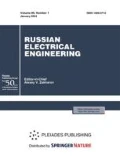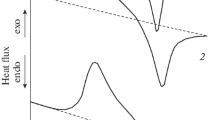Abstract
Experimental data are presented concerning the changes in the characteristics of different polymeric electrical insulating compounds after a rather long holding in water and salt solutions at room temperature and 80°C. It has been found that the water absorption level of thermosetting compounds, as well as the worsening of their electrical properties, such as specific bulk electrical resistance and dielectric loss tangent dielectric permittivity under the action of water–salt media, is determined by the chemical nature of these polymers. The prolonged holding of epoxy compounds in salt solution at a normal and at an elevated temperature leads to water absorption lower than 1% and does not exert any significant effect on the electrical characteristics thereof. The holding of polyurethane compounds in a salt solution leads to a more than a twofold increase in water absorption compared to the epoxy compounds and to such a dramatic change in their electrical characteristics that it makes it impossible to use some of these compounds as insulating materials for manufacturing products that are to be exposed to water and water–salt solutions. The low water resistance inherent in polyurethane compounds and other nitrogen-containing polymers can be caused by a low hydrolytic resistance of the C–N bond occurring in the structure thereof. It is shown that water transpenetration through the layer of the SPB-KhP-80 polyurethane elastomer is quite possible.



Similar content being viewed by others
REFERENCES
Schweitzer, P.A., Mechanical and Corrosion-Resistant Properties of Plastics and Elastomers, Boca Raton, FL: CRC Press, 2000.
Vakulenko, D.A. and Turusov, R.A., Water proof of polymer compounds, Inzh.-Stroit. Zh., 2017, no. 7 (75).
Ulegin, S.V., Kadykova, Yu.A., and Artemova, A.V., Epoxy compounds dilled with dispersed mineral filler, Molodoi Uch., 2015, no. 24 (104).
Zuev, Yu.S., Razrushenie polimerov pod deistviem agressivnykh sred (Destruction of Polymers in Aggressive Media), Moscow: Khimiya, 1972.
Wright, P. and Cumming, A.P.C., Solid Polyurethane Elastomers, New York: Gordon and Breach, 1969.
Glinka, N.L., Obshchaya khimiya (General Chemistry), Moscow: Integral-Press, 2003.
Reitlinger, S.A., Pronitsaemost’ polimernykh materialov (Permeability of Polymeric Materials), Moscow: Khimiya, 1974.
Author information
Authors and Affiliations
Corresponding author
Additional information
Translated by O. Polyakov
About this article
Cite this article
Panov, A.A., Patsino, A.V., Maslov, V.A. et al. Changes in the Electrical Characteristics of Compounds upon Holding in Water and Water–Salt Solutions. Russ. Electr. Engin. 91, 348–353 (2020). https://doi.org/10.3103/S1068371220050107
Received:
Revised:
Accepted:
Published:
Issue Date:
DOI: https://doi.org/10.3103/S1068371220050107




